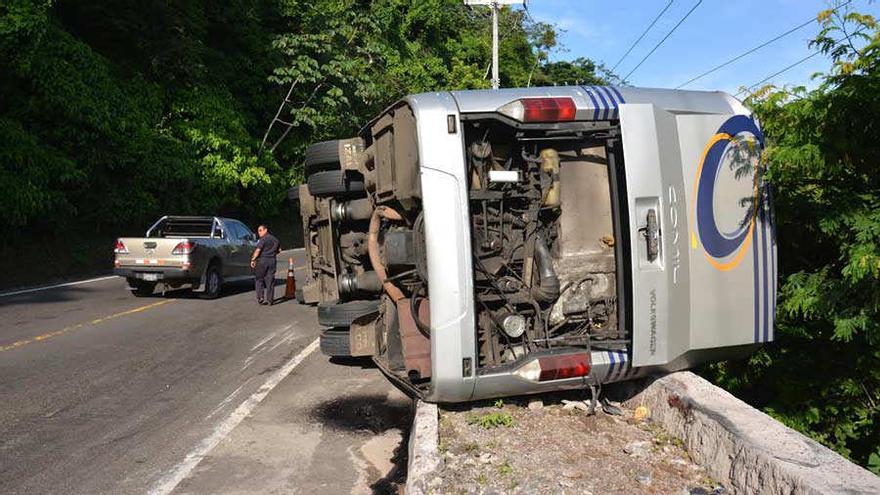
![]() 14ymedio, Havana, 29 March 2019 — On Tuesday, the official press published the report of the National Road Safety Commission with the loss data of 2018 in an extensive report of more than 1,200 words in which no word is written regarding the State’s responsibilities in the 10,070 crashes last year on the island, that left 683 dead and 7,730 injured.
14ymedio, Havana, 29 March 2019 — On Tuesday, the official press published the report of the National Road Safety Commission with the loss data of 2018 in an extensive report of more than 1,200 words in which no word is written regarding the State’s responsibilities in the 10,070 crashes last year on the island, that left 683 dead and 7,730 injured.
The report, far from the informative tone that could be expected in a data document, which only appears in the second half of the report, is characterized by a maudlin tone that even includes in the introduction this sentence: “And we hope that these lines will help to ensure that drivers, passengers and pedestrians, take more care of their own lives and those of others.”
Human error, in fact, is behind 90% of traffic crashes according to the World Health Organization, however, the same agency indicates that the vast majority of deaths in this type of accidents occur in low-income countries, to the point that people of low socioeconomic status are more likely to be involved in traffic crashes.
The WHO report on road safety in the world states that 93% of deaths occur in low and middle-income countries, despite the fact that they have only about 60% of the world’s vehicles.
From these data it is clear that the state of the roads, the vehicles and the security systems, without neglecting road safety education or adequate health care, after the crash, are decisive when it comes to reducing mortality related to traffic.
“The cornerstones of this approach are safe roads, safe speeds, safe vehicles and safe users of the roads, all of which must be addressed to eliminate fatal crashes and reduce serious injuries,” says the WHO, noting that these claims cost countries up to 3% of their GDP.
The Cuban data for 2018 (one crash every 52 minutes) are slightly better than those of the previous year, when 750 people lost their lives in 11,187 crashes and 7,999 were injured. This supposes a reduction of 10% in the number of crashes, 9% in the mortality of victims and 3% of those injured. Despite this, a person dies every 13 hours because of road collisions.
According to the official press, it is confirmed that the number of major crashes increased, from 36 in 2017 to 44 in 2018, leaving a balance of 165 more injured and one fewer killed compared to the previous year.
The report indicates that the majority of those involved in the crashes (5,686 people) were “in full socially useful capacity,” a phrase they use to describe the age range from 21 to 55 years.
Traffic crashes decreased in 69% of the country. The provinces of Camagüey, Las Tunas, Granma and Havana, recorded 36% of the total events (3,661), 29% of the deaths (195) and 17% of the injured (1,329).
Pinar del Río, Mayabeque, Artemisa, Villa Clara and Las Tunas are other provinces in which there are disasters with fatal consequences in which one person died in every second or third crashes.
From Monday to Friday, between 3 and 9 in the evening, are the times when the most incidents occurred. Another fact that is extracted from the report reports the incidents by sectors, with 10,856 state cars involved in crashes, compared to fewer than 5,000 private vehicles.
The authorities claim to have taken some legal measures, such as the withdrawal of 36,000 traffic permits, 233,710 fines and the performance of 13,088 breathalyzer tests that resulted in 31% (4,022) of those tested found to be driving under low effects of alcohol, while 126 were in a full drunken state.
According to the EFE agency, so far in 2019, more than a dozen crashes have been reported, the bloodiest, in January, was the overturning of a tourist bus with 40 people on board on a dangerous road in the province of Guantanamo, which caused the death of seven passengers (three Cubans, two Argentines, one German and one French) and caused injuries to 33.
The National Road Safety Commission indicates that during the mandatory inspections, “technical deficiencies were detected, mainly with the brake system, steering and lights,” in 44% of the verified cars (63,966), a fact that confirms the poor condition of the vehicle pool. The difficulties in acquiring new vehicles, along with those of obtaining quality repairs, are a perfect scenario to drive cars that, on occasions, represent a public danger.
The official newspaper Granma, as the government spokesperson, ignores the responsibilities of the State in road safety and sidesteps the issue with: “As popular wisdom already says, nothing has to do with chance, and in that ’reckless’ way on more than one occasion we assume the risks.”
The 14ymedio team is committed to serious journalism that reflects the reality of deep Cuba. Thank you for joining us on this long road. We invite you to continue supporting us, but this time by becoming a member of 14ymedio. Together we can continue to transform journalism in Cuba.
